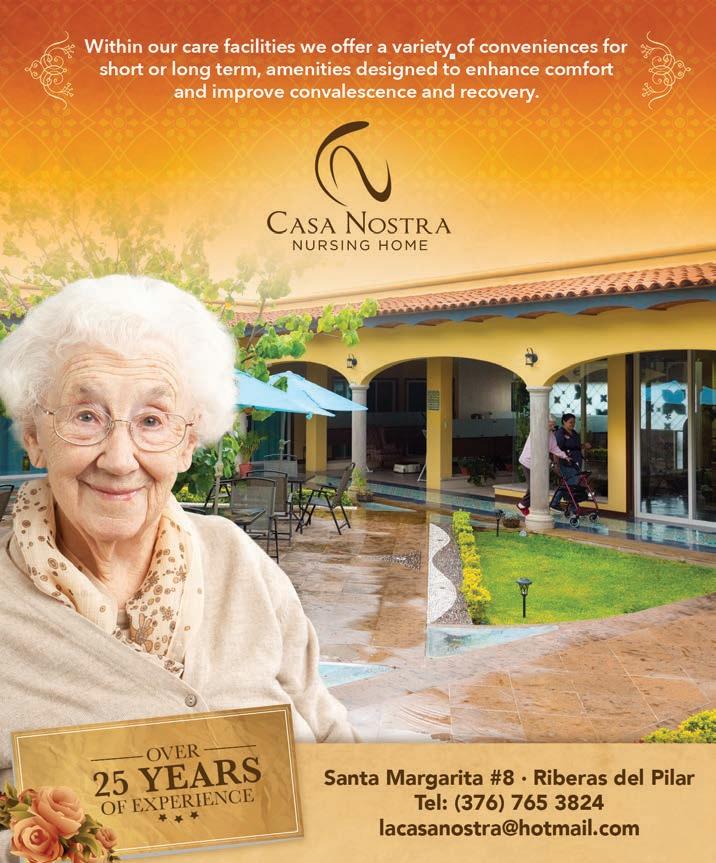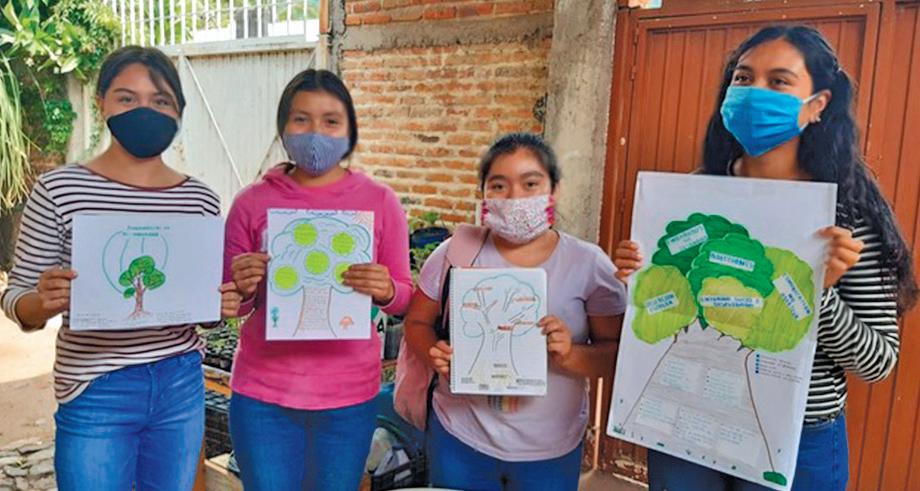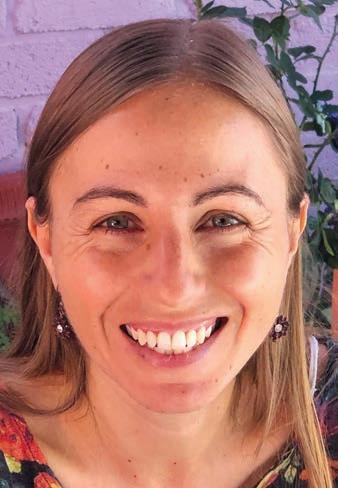
50 minute read
Fragment of the Memoir Infancia (Innocence) In his first submission to
By J.A. Garcia Torres
Chapala is like a strong
Advertisement
and leafy tree. Like a yellow amate, its branches expand, grow, touch the sky, peck at the clouds; its roots sink, stick, twist; they sneak into the water, into mother earth, they latch on to the entrails of Tlali Nantli, to her matrix which is also her womb and cradle. Her lake is an inexhaustible source of life, pure fertility where the sap and cord of all things that are made to grow abound.
There are ancient families and there are new ones. In their veins they carry coca blood from our Nahuatl ancestors and also, inevitably, blood from the grim conquerors,

those who had come striding from afar, destroying everything in their path, imposing themselves with a stubborn religion; with killer microbes, with daggers and primitive harquebuses. Those men had their faces red from the sun and cracked by the winds from afar. From their wiry beard, the spit that lubricated a new language dripped, full of words such as gold, corn, and land. They wanted everything for themselves. A rotten smell escaped from their boots, and from their nags’ horseshoes, a spark of agitation and fear.
A race never before seen had come to that beautiful place, superior to the natives in malice but not

in spirit; their sagacity was greater but not their essence. With a roll of good intentions, they subjugated them with religions and the scourge of a distant kingdom represented by friars, soldiers, and courtiers of a crown from the Old World. The place was invaded by Spanish devils dressed as saints who stuck their tail until they populated its valleys, its hills, its mountains. Wherever they felt the heartbeat of the land, they settled. With the help of the Indians they enslaved, they dug wells in the courtyards of the houses they built; and placed knockers on the shutters with a crossbar that they never secured. They raised walls with adobe and stones they took from the mountain, then built roofs with wooden beams, palm leaves, and tiles they made with clay.
Pigs that the men in helmets had brought from afar grew fat in their pens, while they made feeding troughs to the nags the old Franciscan friars rode and built corrals where they raised cows and goats.
All who came to Chimaloacán found peace and plenty to do. This wetland had a unique climate capable of offering fruits of the earth in abundance with a fertile flora, a generous land, and an aquatic fauna to ensure sustenance for generations. The people who lived there were healthy and happy people with a peaceful mind; the men were strong and the women fertile, so the place of the shields, as the Indians called their village, grew rapidly through the years and centuries until it became home and final destination for a people that was slowly molded until it became what it is now.
With the passage of time, miscegenation produced a new nation, the bronze race multiplied, invasions from other parts of the old continent brought other cultures. Modernity arrived bringing railroad tracks to the shores of the lake. The steel horse snorted progress in the midst of a Mexico that had recently been cut in half by invaders from the north half a century ago, and now it was beginning to divide amongst its own people. A civil revolution was in the making as a result of a rebellion against the dictatorial yoke that was trying to dispossess los de abajo, the underdogs, the peasants, of what little they had left, which was the land they cultivated to sustain.
It didn’t take long for boats to navigate the high tides of the lake and for cars to start moving from Nueva Galicia to Chapala. The industrial revolution, although late in the new continent, brought changes, among them a class society and a sense of superiority towards the darker race whose genuflection was not in perpetuity.
It is risky to narrate centuries in a couple of paragraphs. However, this is not a treatise on history nor a chronological document. The tree Chapala is, has gradually been taking shape, it has been growing, expanding, shedding its skin, evolving and sharing its shade with whoever comes to it. A spirit of life and happiness abounds in its core, in its trunk strength, and in its roots the wisdom that is recycled into new leaves that sprout from its robust branches. Each leaf is like the tile of a huge vault that protects those who find refuge under its thick foliage. In its branches there are always birds, their song is a perpetual concert of joy and uproar.
The joy of the people, then, is innate, their traditions a witness that they are relieving to the new generations so that their genuineness persists, and their culture is strengthened. That is why people who come fall in love, many stay, others promise to return.
From Innocence, a memoir (to be published) J.A. Garcia
Torres







Carol D. Bradley Email: cdbradleymex@gmail.com Phone: 33-2506-7525
“There is but one solution to the intricate riddle of life; to improve ourselves, and contribute to the happiness of others.”
Mary Shelley




Open Circle
Open Circle, under the new auspices of The Lake Chapala Society, is making plans to cautiously resume live presentations on the spacious LCS south lawn November 1. Care will be given to protect the health of all attendees through limited seating distanced 6 feet apart, obligatory use of masks, temperature checks on entry, and hand sanitizers. Because seating will be limited to around 100, a reservation system may be necessary. More detailed reopening plans will be forthcoming soon.
Chairs socially distanced on the LCS south lawn. A raised stage is set up for the speaker.
We’re opening on November 1 with Kassandra King speaking on Alzheimer’s Disease, a subject of great interest to all of us and presented by an expert.
November 1.
A World with Alzheimer’s
Presented by Kassandra King, BA, NHA, RCFE
Kassandra’s presentation will bring new perspective to Alzheimer’s based on observations of how “losing touch” with “agreed upon reality” can, at times, be a relief for the person experiencing cognitive change.
Kassandra’s interest in the geriatric population began as a volunteer at a young age. She enjoys the wisdom of elders and uses her natural abilities to connect with persons who have cognitive impairment. With a BA (University of North Texas) and post-graduate certification in long term care administration (Texas State University), Kassandra worked as a licensed nursing home administrator at multiple care facilities.
As Public Policy and Education Director, Kassandra served at two chapters of the Alzheimer’s Association. The term “new normal” is present throughout the guidance from her published book Getting REAL About Alzheimer’s– Dementia through Engagement, Assistance, and Love (Plainview Press, 2014).
Due to technical difficulties with the Open Circle YouTube
Kassandra King channel, online presentations are not available. We apologize for the inconvenience.
Back Stage Theatre and BRAVO!
One of the first business casualties of the global pandemic was live theatre, and it is greatly missed - all the more so with the economic destruction involved, to both commercial and individuals’ interests as a result.
Never ones to avoid a challenge, Roseann Wilshere of the Bare Stage and BRAVO! Theatre’s Jayme Littlejohn put their heads together. As a result, until their individual productions can resume, they have joined forces to host two actors’ workshops being given by the award-winning comedian, actor and teacher Jo Romero, from the Actors’ Temple in London, England.
Romero is an award-winning comedian, actor and teacher with more than 25 years of extensive experience in the performing arts - most recently coaching in LA, London, Paris and New York. She will be bringing her unique style of teaching that encourages students to take risks, step into the unknown, work from their instinct and play!
The workshops will allow performers of all levels to fully immerse themselves in the process and learn some valuable acting skills. They will cover a lot of ground, including the difference between ‘showing’ feelings and really feeling them; how to access strong internal emotions and how to rid yourself of self-consciousness while being watched. Romero will also cover how to act with spontaneity and instinct, moment to moment and how to become a more interesting and dynamic actor with a broader casting range, amongst many other valuable insights.
Romero will run two 40-hour face-to-face group courses on the Sanford Meisner Acting Technique at the BRAVO! Theatre, Riberas del Pilar. The class size of both groups will be 14-16 people and they will take place at 9-1pm on 9-20 November for Group 1 and 2-6pm on 16-27 November for Group 2.
Fees are $5,900 pesos per course but both groups qualify for an early enrollment discount with fees reducing to $4500 pesos for fully paid up bookings prior to 15 September 2020. Registration is by email at <mymytickets@gmail.com>
Now that restrictions are gradually being lifted here in Jalisco, at Bare Stage tentative plans to reopen are being laid and cautiously firmed up. Production decisions are still reliant upon the evolving Covid situation, but the outlook is becoming more positive.
“We have many plans on the go, and hope that Bare Stage will be able to resume its former monthly events, as soon as it is safe, but we will not expose our patrons to Covid to pay our rent!” Said Artistic Director, Roseanne Wilshere.
Because of Covid-19 all theatres must now comply with essential safety measures. Bare Stage has obtained its Chapala Municipality permit to open and is limited to a maximum of 35% audience capacity, no bar or snacks, and everyone present must wear a mask. There can be no exceptions.
While patrons’ fingers remain firmly crossed and organizer’s lips zipped regarding details of future productions, all being well we may yet see Bare Stage productions again before Christmas.
Keeping the Music Playing
Although the Lake Chapala Community Orchestra has been unable to rehearse or perform since March, due to the Covid 19 restrictions, it has been active behind the scene recently in an initiative to raise much needed funds for Musica para Crecer.
Based in San Juan de Cosala Musica para Crecer, also known as Orquestra y Coro Filarmonica Infantil de la Ribera de Chapala, was formed in 2013 with the aim of providing under privileged children between the ages of 5 and 18 in the Lake Chapala area the opportunity to learn a musical instrument and sing, all within a setting of encouragement, positivity and a sense of community belonging.
Under the guidance of Coco Wonchee (President) and Daniel Medeles (Artistic Director) Musica Para Crecer has been an unqualified success with over 150 students enrolling in the organization’s programs and performances. A number of these students have appeared in the ranks of the Lake Chapala Community Orchestra.
Regrettably extensive Government support was recently withdrawn due to budgets that were drastically reduced in Federal and State education/cultural programs throughout Mexico.
In an effort to keep this important organization going and replace the funding the Lake Chapala Community Orchestra’s conductor, Michael Reason, organized a GoFundMe campaign and invited orchestra members and supporters to contribute and spread the word about donating to this important cause.
The campaign quickly got noticed and hundreds of Lakeside residents and many people from Mexico, the US, Canada and Europe generously donated to the fundraiser. The campaign closed on August 31 and the sum total raised was in excess of $50,000 pesos!
“The generosity of all the donors will enable Musica para Crecer to continue their important work in providing a musical education for the young people of this region” said Reason.
Reason continued by saying that “The importance of cultural activities in any community is paramount to the health and well-being of our society. This is why Musica para Crecer is such an educational treasure.”


Michael Reason (Conductor, Lake Chapala Community Orchestra), Soco Wonchee (President, Musica Para Crecer) and Daniel Medeles (Artistic Director, Music Para Crecer).



ChangeMakers, Creating Success for Girls
By Margaret Porter

The newest program at Lakeside to benefit girls ages 15 to 18 is ChangeMakers Lake
Chapala. The program offers girls a chance to grow personally and sharpen leadership skills as they grow into adulthood. The program helps with personal confidence, pride in their culture, health and wellness, continuing their education, envisioning a career, and community service.
Through the leadership of Monica Masini Aguilera, program coordinator, the girls meet weekly to immerse themselves in learning and sharing experiences in the central program “Young Roots.” Participants are also provided the opportunity to participate in a weekly Breath & Balance class, to become part of a community garden/huerto in San Juan Cosala under the guidance of Francisco Nava, and, as an elective, they may join ongoing ESL classes through an existing program in San Juan Cosala. Soon, Masini Aguilera will guide each participant on an individual plan toward attaining her life goals and career plans.
Masini Aguilera is aided by a group of mentors called “inspiradoras,” who are Mexican women from the professional, business, and social services fields. Providing overall guidance and financial support is the board of directors, members of the foreign community.
The program was started in San Juan Cosala at the outset of the pandemic–nothing was going to stop them! Plans are to start new groups in Ajijic and San Antonio Tlayacapan this fall, following all the safety guidelines.
If you’re interested in volunteering or financially supporting ChangeMakers Lake Chapala, contact janquarton@gmail.com. We also invite you to visit our website https://changemakerslakechapala.org/, and find us on Facebook and like our page.
Here’s what a few of the members say about the program:
Jimena
Since I joined ChangeMakers, I am a much more confident woman in the things I do, and/or in myself. Participating in this program has helped me to meet women who, like me, are determined to change the environment where we are, and to realize our dreams. In the same way, I have discovered that I am capable of things that I did not know I was capable of.
The most important thing is that I am learning how to lead my life and know who I am. In a personal aspect, it has helped me to be a better daughter, friend, and family member, to be a person more aware of her actions, with more optimism when doing activities.
Vanessa
This new program has helped me in many aspects, but the main change is that I am beginning to accept myself. Before, it was very difficult for me to accept myself as I am. Now I can also be more at peace with myself. Before, I was very concerned about what others said about me. I asked questions like, “Am I doing it right?” “What do others think of me?” “Am I weird?” Those questions hung around my head all the time, and it’s not like that anymore. Seeing these changes, I realize that this program really works, or at least it is working for me. I thank God for giving me the opportunity to participate in this project and for putting these great women on my path.
ChangeMakers held a class about communication, lead by Professor and Inspiradora Mariana Almaguer. The participants discussed the function and elements of communication, body language, and expressing emotions assertively. “Young Roots” explores the girls’ relationships with their families, friends, and their community. Here, the girls show their homework from the prior class where they drew trees with branches and were asked to show five problems in their community. In the roots of the tree, the girls were asked to draw or illustrate the “root causes” of the problems as they see them. They discussed how problems can have many different causes and how we approach problems from differing perspectives, varying influences that exacerbate the problems, and what potential solutions might be.


Jasibe
I have learned so many things and I have had beautiful moments. Starting the activity of the garden created by Dawna and Rodrigo in San Antonio, I found it super-interesting and fun. I realized that I like plants very much, something that without ChangeMakers I would not have realized. Then we opened the Coxala Garden in San Juan Cosala, which I am really enjoying, and I have learned even more things.
I love Monica’s teachings about our indigenous cultures, to reconnect with them with dances, songs, and new words. I felt very relaxed and more connected with nature and my heritage. Our Young Roots workshop, where I have learned to value myself as a person, is gratifying to me.
Diana
The Young Roots ChangeMakers curriculum is helping me to better manage my emotions and be a better person. I have attended four classes in which I have learned to channel my emotions, also to meet more people and have a good relationship with my classmates.
Gaby
My learning in this program has been to accept ourselves as we are. We don’t need anything to realize that we are beautiful. I have also learned to manage my emotions and learn more about them.
We have to be able to send good vibes and get good vibes. This project has also helped me to become a lot calmer with myself and my dad.
Alondra
This program has helped me to get to know myself better in many areas. I currently am working to improve being more responsible with my obligations and activities, and working to maintain proper physical and mental care, which I must keep balanced. This has caused me to become more observant around me as well as to focus on some topics of interest to me.
I love the trust that exists today with all of the ChangeMakers participants and how we listen to each other, how we see our surroundings, what we want to achieve and how we will do it.
Jazmín
Personally, I take more care of myself. I love myself. I don’t feel bad about being the way I am because I learned that being me makes me special because of my essence. I better manage my emotions when faced with a conflict which is what generally disturbed me the most. Now I relax and solve the facts calmly. I no longer say such rude things because I live with many people. I adopt words from others and replace those bad words with kinder words.
I am more interested in the time that it takes to learn something new. I learned to socialize more. I allow myself to laugh and be myself at all times. I am able to say something about myself with positive aspects, and I also recognize my deficiencies. I am working to improve the things that I want to change.
Juliana
When I started in the program, I was scared, afraid of not being accepted, afraid of not being able to achieve every objective that was in front of me. As time went by, the opportunity came to go to an organic garden, where I learned a lot about both fruit and flower plants. I learned to treat the land well and to enjoy nature and most importantly to connect with it. As time went by, each and every one of my insecurities were erased, taking me deeper.
I love being part of this team and I
can say that it is one of the best decisions I have made. Thank you for everything. I hope to continue growing as a person and learning from everyone who is part of ChangeMakers.
Maria Jose
I think that at first I felt a little nervous and insecure of myself. I thought that maybe I could not do the things that were required. In reality I did not know how to manage my emotions and feelings. The Young Roots classes have been serving me well, since little by little I have been trying to manage my emotions in a more adequate way and to trust myself.
ChangeMakers Lake Chapala’s program director, Monica Masini-Aguilera, a native of San Juan Cosala, brings a diverse body of education and experience to the program. She has a Bachelor of Science in Education from ITESO University, and a masters’ degree in Education and Management of Knowledge from the same university. She is fluent in Spanish, English, Italian, and speaks a little French. She has been a school teacher in the third and fourth grades, has taught dance for cognitive and social-affective development, developed and taught social intervention models at the university level, and has been a research assistant in poverty and migra
Monica Masini-Aguilera


tion. She developed a project for the Distrito Federal about Human Rights, and another called “Youth Without Violence Project.” She began her career as coordinator of a community health project and primary school teacher in Chihuahua. One of her passions is dance, and she has taught ballet. Margaret
Porter


By Herbert W. Piekow
Many people think of Día de los Muertos, or Day of the Dead Celebration as a Mexican holiday.
However, the truth is the Mexican celebration of death is actually an amalgamation of several cultures, but with a uniquely Mexican twist. Anthropologists and Mexican historians postulate that the rituals honoring the dead began in Mesoamerica between 3,000 to 5,000 years ago as a part of life. The first settlers realized that death is a part of one’s life cycle. When someone died that person began a challenging journey, and for this adventure to Chicunamictlán and finally Mictlán, the dead, like the


living, would need food, water, and tools. Today’s Mexicans place these necessities either on a deceased family member’s grave or on a home altar. Although, today’s libations usually include tequila or cerveza to help boost the spirits along on their journey.
The indigenous peoples set aside time in August to honor their ancestors. November First, or All Souls Day, was easily adapted by native Mexican people upon conversion to Christianity. Just as early Christians had adapted the Roman festival honoring the deceased, the first people of the Americas adapted their festivals honoring ancestors with bonfires, dancing and feasting. Once more the Catholic Church adapted existing festivals into their beliefs and practices. When the medieval Spanish arrived in Mexico they brought their tradition of visiting gravesite with wine and pan de ánimas (spirit bread) to the gravesites. The Spaniards also covered graves with flowers and candles to guide souls back to earth for a visit. Which today’s Mexicans can sometimes carry to creative and excessive extremes, but that is really a part of the beauty and enjoyment of this celebration. Sometimes neighbors and businesses compete to see who can be most creative, or extravagant.
El Día de los Muertos is more than an adaptation of Spanish Catholic and indigenous beliefs and customs. It is not a Mexican version of Halloween, but is a Mexican celebration of life that pays homage and gives respect to those who have preceded us. UNESCO recognizes that Mexicans celebrate this fact of life in both a truly “Mexican” and unique way and for this UNESCO has bestowed the term of Cultural Heritage to Mexico’s celebration.
Although Day of the Dead, or All Souls Day, is as old as civilization, in Mexico the honoring of the dead continues to evolve, thanks to art and the movies. In the last part of the 1800s the Mexican artist José Guadalupe Posada drew an iconic political cartoon mocking the rich women of President Porfirio Díaz’s entourage, these women were portrayed as fashionably dressed skeletons which later influenced Diego Rivera’s mural, Afternoon in Alameda Park, where he included a skeleton in an oversized hat and elegant clothes. He named her Catrina, which is slang for Snooty Rich Woman, and today we call these well-dressed skeletal dolls Catrinas. Some people collect these dolls, and many more people dress as Catrinas, to celebrate Halloween, by painting their faces to resemble skeletons while dressing in exaggerated style.
Today the movies spread the message not to take death too seriously because eventually we will all break our earthly fetters. The upbeat Pixar movie Coco showed the fantastic and colorful world of the dead and their yearly re-uniting with the living. The movie, beautifully illustrated and enhanced with music and vibrant colors and great dialogue, showed that although our loved ones may be gone, they will live with us forever as long as we remember them. The James Bond movie Spectre also helped spread the Mexican Day of the Dead festivities to a worldwide audience as Bond and his pursuers raced through a colorful parade of Catrinas and other celebrants. The animated movie The Book of Life gained international following because it blended Mexican culture with European fairy tale when the rulers of the Land of the Forgotten and the Land of the Remembered wager for the soul of one young man. However, it is not a Faustian tale, it is a brilliant and truly colorful Mexican story.
Whether you to go the Pantheon to see the beautifully decorated graves and mingle with people remembering their loved ones, put a ghost or jack-o’-lantern on your porch to celebrate Halloween, or not. Think about covering some boxes with a nice tablecloth, arranging a few family photos, setting out some pan de muertos and buying some marigolds for your altar and pray that someone will do the same when you are no longer here to celebrate a life well lived. Herbert W. Piekow








Congruence
The articles, notes and commentaries that appear monthly in the pages of El Ojo about the experiences of foreigners living in what some of them call Lakeside, overall tend to be well-meant, positivelyminded or at least duly respectful. One of their best examples are the articles Ms. Victoria Schmidt has written in her columns.
However, it is frequent to also find others that not only criticize but also make a mockery of deficiencies and/or insufficiencies local services or infrastructure can have in Ajijic or Jalisco at large. Significantly, all of these contributions seem to be written by U.S. citizens.
The two articles by Tim [sic] Nussbaum that appeared in the August issue of El Ojo are a case in point that seems to have come to epitomize that kind of contributions. His comments are not only in large part unfounded but, what is worse, also scornful and openly offensive; witness expressions like “… the crap I had to go through to get a damn Mexican driver’s license” and “…the goal of local bus drivers is to break the Guinness Book of World Records for the Number of Passengers Stuffed into a Bus Aisle Narrower than a Guitar String Wearing a Corset”.

Articles and expressions like these deeply disrespect and affront all Mexicans, in particular those who, as my wife and I, live in Ajijic and get to read El Ojo. We lived for several years in the United States (shorter periods in Canada, China and Korea as well), but we never used a Mexican magazine or newspaper to complain about the negative sides of our experience there and less to offend the people of that country whose official language, by the way, we did speak.
The point is that it is dishonest and patently incongruous of U.S. citizens like Mr. Nussbaum to come to live in Mexico, enjoy the pluses and goodies it offers, but at the same time be always complaining about and mocking its deficiencies and shortcomings. What they should do in this case is simply to go back home or elsewhere, nobody is forcing them to live here. But, should they choose to stay, the least they ought to do is to show a due respect for this country and its people, take it in bundle including those shortcomings, and also show some appreciation for what they are enjoying here, beginning with the warmth and hospitality of what many of them contemptuously refer to as “locals”.
Juan J. Palacios, Ph.D.



By John Thomas Dodds

only ever one glass of wine no matter how beautiful the pair might seem together, each crafted individually, exquisitely unique engendered with a particular essence a minion among snowflakes, crystals, stars. Yet nothing about us uniquely other than one person, an individual cell, a single being, being human, one body, one mind one soul of an old and scarly cat, smugly contemplating tolerance. Everything we love expresses how we feel about this organ of water and air, this mind of matter and darkness, this exposed soul of a universal want and need.

To plant the seed that I am the earth I stand upon, I live in light and love I breathe my air I admire the flower that I am that grows upon the earth I nurture with my tears of joy for as I turn from day to day the wind I create caresses my body. I am the earth I am all that I see, all that I feel all that I can be. If we were one light how brilliant would we shine. The heavens would cease running away and look back upon us as the star over Bethlehem or the light of Mecca. If we were one surface monumentally varied and etched with the wisdom of ages what a beautiful color our skin would be blinded by the light and sensitive to the touch. If we were one breath, drawing in everything that has been, nurturing every pore of our being, in an understanding that with a sigh of recognition we are the earth all that was, is, and will be
then, and all that we can see is what we imagine love to be







This is a regular feature column inspired by the September 15 , 2019 Open Circle presentation of stories that manifest “Mexican Grace.”
El Ojo is looking for more anecdotes that relate the many encounters, initiated by expats or locals, that exemplify the special forms of mutual giving and receiving that define the Mexican Grace that brought us to this unique paradise--and that keep us here.
Please email articles of up to 900 words with a Title and your name at the top to both victoriaAschmidt@gmail.com and loretta.downs@gmail.com.
Photos are welcome.
MY ROSA
By Lillian Norma
Today I cleaned my whole house. As I cleaned, I
thought of Rosa. Oh, if Rosa could see me now! In all probability, we would argue. How I miss and long for my Rosa and our arguments
Rosa is our maid. She just fell into my lap. Or rather, I literally fell into hers. Our house included everything but kitchen items. Because my partner and I love to


entertain, I walked to Walmart to purchase a couple of sets of dinnerware, pots and pans, and the like. “And the like” became two extra bags of doodads.
At the checkout, I knew walking home with four heavy bags was out of the question. Luckily, the bus stop was close by. As I edged and squeezed my

self down the aisle of an overcrowded bus, my eye caught a woman motioning me to an aisle seat. Just as I sat, the bus lurched, throwing me sideways and into her lap.
“!Lo siento, lo siento!” I exclaimed.
“No importa, señora, no importa,” she said with a smile.
How often I would be hearing those three words in the coming years! “No importa, señora,” she repeated, hanging onto a bag that had fallen with me. I indicated I could manage but she refused to relinquish it. Thus began our first argument. She had the bag. I didn’t. She won.
We tried communicating with my limited Spanish and her limited English. From Walmart to mi casa, we learned she was a maid and I needed one. Cleaning our spacious house was an onerous job so I succumbed to our friends’ suggestions to hire a local and add to the economy of este lugar.
As my house was cerca I rose to get off the bus. She smiled that big smile of hers. “Tengo un cliente in Mirasol. Voy con usted.” She “wrestled” the other heavy bag out of my hand and led the way.
I tried to retrieve it but she smiled and shook her head. “I’ll take one, señora, por favor.” Her grip tightened as she walked away, motioning me to follow. She had won. Again.
She walked through each room of my house, nodding her approval. Within ten minutes, I had a maid and she had secured another job. Our new “contract” had her returning the following el miercoles. Miercoles is a favorite Spanish word of mine and it grew even more special each week that Rosa came to work for us.
Routines were established. Each miercoles, she opened the street door, walked up the sidewalk, allowing her eyes to glance inside the living room window. We would see her and came to welcome that glance of hers. It was part of who and what Rosa was to us.
My partner brewed extra coffee every miercoles. “A cup for Rosa,” he’d say. They exchanged “Buenos días, señor ¿como esta?” and “Buenos días, Rosa. How are you?” Their smiles warmed my heart.
Our exchange was, “Buenos días, Rosa, y ¿como estás? Tu familia está bien?” She politely corrected me by responding, “Sí, y ¿usted familia?” She won again!
A trust soon formed in this unique relationship. We left Rosa alone and went to the Wednesday market. Her music would blast so she seldom heard us return. We traipsed our dirty shoes across her newly cleaned floors. My chorus of “lo sientos” preceded her “ No importa, señora, no importa.”
Every week we walked on her wet floors. Oh yes, they were her floors! “No importa,” rang in the air as her mop ridded any evidence of our disrespect for her labors. Later, she acquiesced and ate lunch with us, as she was far too polite to beg off to complete su trabajo.
Over the years Rosa became as much of a friend to me as a maid. We valued each other’s friendship and our working relationship changed. Cada miercoles señor greeted her with her cup of coffee. After our usual buenos días exchanges, I led her from room to room telling her what not to do. “Rosa, no es necesario, hoy.” Her look said, “Pero, señora, es mi trabajo.”
“Quizás proxima semana. No need to clean ‘esa habitación porque nadie lo está usando.”
“Pero, es mi trabajo,” she insisted. A shake of my head indicated it was a waste of time arguing. She would shake her head and walk off.
Each week I invented some reason not to clean something. She soon began to regard me with some suspicion. Rosa would never “disobey” me, but she got me back one way or the other. To prove “pero es mi trabajo, señora”, she did something completely different. The dust-free fans explained why the step ladder was out when we returned from the market.
One day we could not find her. She was under the dining room table “getting rid of possible spiders, señora,” she said with a sly grin. Another day we found her with a plastic bag on each foot as she walked along the kitchen counter cleaning the top of the cupboards. She won every “argument” on this no es necesario, hoy, topic. Week after week we played this game. I invented ways for her not to work so much and she invented ways to do it anyway.
Then came COVID-19. No one went out. No one came in. Self-isolation. Social distancing. El miercoles, I sent Rosa a text, “Lo siento, pero no venga a casa hoy y próxima semana, Rosa.” I sensed her anguish. I knew she was losing some of her jobs as people were advised to return home. My next text was a request for “su dirección, por favor, and I will drop off your pay.” She was worth every peso.
“Graciás, señora, usted mi ángel de la guarda,” was her response. My response? “Por nada, Rosa, graciás a usted.”
So, today I cleaned my house. No one opened the street door. No one glanced in my living room window. No music was blasting. No mysterious job got done behind my back. No Rosa. No nada.
Rosa, please come back so we can argue again. You know you will win!
I miss my Rosa. Lillian
Norma








By Day Dobbert
Billy was mute but was without other physical
problems; he could hear, and he could communicate—after his fashion. Camarillo State Mental Hospital indicated a diagnosis of paranoid schizophrenia and, though never verified, his having witnessed his father killing his mother. There was speculation that the father may have threatened to kill Billy as well if he ‘told.’ The records held little more of substance.
Billy, in his early twenties, was a resident at L.A.’s Beverlywood Aftercare Center, one of the open psychiatric halfway houses in California emerging in the 70ties when locked institutions were spewing out revolving door patients into a world where they could barely function. I was Billy’s volunteer counselor; I connected with him through a work/study program, affiliated with U.C.L.A and VISTA, President Johnson’s “Volunteers in Service to America,” a one-year, full time commitment. My on-going work with a documentary film company had been suspended temporarily and I leapt at this opportunity to fill the hiatus. I would divide my time between the Center and a four-quarter course at U.C.L.A. leading to a Certificate in Social Services. This tied in beautifully with earlier graduate work at the University of Chicago and recent in-patient hospital volunteerism in the mental health field.
Billy, in his early twenties, was boyish and fit, with a wining smile and expressive blue eyes which sometimes hinted at a sense of humor. His grooming, including a mop of thick blond hair, was exemplary, and he kept his part of his shared apartment shipshape, one of a cluster of converted bungalows which made up the Center.
Yet Billy had a short fuse, a clue as to Camarillo’s diagnosis. There were occasions when, suspicious of male residents’ intentions, he picked fights with them, sometimes violent ones. Though seldom justified, his acting out seemed motivated to protect the ‘honor’ of the women residents; was this something he had been unable to do for his mother?
We offered myriad activities at the Center, but Billy’s self-imposed silence made socializing near impossible. Although he chose to take solitary walks away from the facility, sometimes far afield, he didn’t quite fit Camarillo’s stereotype. He returned for his medications at the scheduled hours, consumed his meals with gusto and never missed his appointments with me. Such as they were. I never leaned on him and initially worked only at gaining his trust.
He was an attentive listener and communicated appropriately through body language, animated facial expressions and lively gestures; pencil, and paper were always on hand, with reading materials to share. I made it clear that if he didn’t want company on his neighborhood junkets, I would leave him be.
Then things changed. After one of his walkabouts, a buoyant Billy returned to the Center with a small, yellow dog trotting happily beside him. The little stray was a friendly, tailwagging character of indeterminate breed, and it became clear that Billy meant to keep him, for their bonding was immediate. No pets, however, per City health codes, were allowed at the facility; we risked a fine, or worse, loosing our license—and the dog. Billy kept him under wraps, nights secreted under his bed. He scavenged scraps of food from the dining room and slipped them to a grateful animal, and he scrupulously disposed of any telltale poop.
Billy’s exploratories around the neighborhood continued, now with his canine as companion, but he also started spending more time at the Center. Once ignored by his fellow residents, Billy, with dog in tow (but out of Administration’s sight), had become a person of importance, and he lapped up his new-found popularity. Predictably, however, exuberant bark ing betrayed them, and I was summoned to the Office.
I was on cordial terms with Brian, the Director, but he shook his head over my collusion with the duo, re- minding me that he was accountable to City higher-ups. “But Billy’s social- izing!” I exclaimed. “Look how he’s changing. We can’t take the dog away from him!” Brian tried protesting, but I persisted, pointing out that we’d been inspected only weeks earlier. “No in- spector’s coming back for another year. Who’s to know,” I said, then added quietly, “Billy loves that animal.”
I won the day; the dog would not be dispatched —“for now,” Brian had em- phasized. I left the Office with thumbs up, but Billy, ever mute, understood, if not altogether willingly at first, that Administration’s requirements were provisional and non-negotiable: ~ No dog in apartment. Billy, balked but minimally. He fetched a box from the trash, put an old t-shirt shirt of his inside it, and sheltered it outside by his bedroom window. ~No dog in dining room, no scraps from plates, no licking up spills from floor, no begging in kitchen. Not so easy. How would Billy obtain his foundling’s food? ~ Billy was to create signs for post- ing in the neighborhood. He was not happy with this one, and a brief lecture by me on the importance of showing ‘good will’ followed.
Billy would finally comply when I suggested that probably the dog had been abandoned, but if not, he could offer to help its owner. Billy’s sign— I would add the Center’s telephone number—read: “FOUND — Little Yel- low Dog. He is hungry so I am feeding him. If you want, I can walk him for you. Contact Billy.”
I provided kibble for a limited time, but ultimately food was Billy’s respon- sibility, and he was flummoxed. His stress level mounted, and he repeat- edly reached for his cigarettes. Yet cigarettes would lead to a win-win solution. Part of Billy’s monthly Social Security Disability benefits went to- wards maintaining him at the Center; the balance was his for pocket money. “Billy,” I asked, “you’re smoking a lot these days. What’s that costing you out of your SSD?” Billy pondered, then presented a calculation. “Well,” I said, “ how much dog food would that cigarette money buy? Find a pet store on one of your walks and check it out, maybe see about cleaning cages or sweeping floors for extras. Think about it.” I could see wheels turning as Billy ended the session.
For my part, I ran some interfer- ence. While my documentary produc- er travelled the world scouting loca- tions suitable for under-water filming, I searched a nondescript L.A. neigh- borhood for pet stores—and found one. I explained to the proprietor, with psychiatric detail simplified, that a nice young man with a speech deficit might be coming in for a ‘talk.’
Time passed, and our plan fell into place—with Billy nicotine-free! The day had come to ask: “You haven’t picked a name for this little guy.” I pointed to his pal who was snoozing nearby. “Some folks are calling him ‘Mutt,’ I teased. Billy rolled his eyes in mock disgust; his buddy was no ‘mutt.’ “What about it? Give me a name.”
Billy gazed heavenward in contem- plation. I picked up a pencil and, for no particular reason, scribbled: “The quick brown fox jumps over a lazy dog.” Billy craned his neck to have a look. “Every letter in the alphabet ap- pears in that sentence,” I informed him. Did he care? No. A little smile had told me otherwise.
Billy took the pencil, dramatically x’d out “lazy,” then, “brown fox,” and wrote his own abbreviated version: “Dog jumps quick.” Billy cocked his head towards his animal, and with the name he’d chosen on his lips, called out—called—in a sweet, clear voice: “Dog.” Dog twitched his ears, shook himself awake, then made for Billy at break-neck speed, and, jumping onto his lap, looked up at him adoringly. Bil- ly had spoken; he‘d broken his silence.
END

Note: Day Dobbert is a self-isolat- ing ‘single,’ who, in the midst of Co- vid-19, shares her home with two dot- ing kitties, born in her garden at the height of last year’s rainy season; their starving, feral, but protective mama had sought refuge for herself and her litter amongst thorny bougainvillea foliage. Day cannot imagine how she’d fare in these stressful times without her foundlings’ companionship and believes rescue animals especially en- rich the lives of their caretakers. For Billy, she says, Dog’s unconditional love was probably the first he’d ever known.








By Sally Asante World “History” part 1

De c a d e s ago I had the good fortune to come across linguist and humorist Richard Lederer’s column in a court reporting trade magazine, and have laughed my way to expanded
knowledge ever since. Just when you think you have a handle on something, Richard has a way of hilariously turning what you think you know on its ear. Following is the first of a two-part series of examples he compiled of World History as retold by eighth grade to college level students who did a bit of ear-turning of their own:
The inhabitants of ancient Egypt buried their mummies and daddies in the pyramids, and they all wrote in hydraulics. They lived in the Sarah Dessert, which they cultivated by irritation and over which they traveled by Camelot. The climate of the Sarah is such that the inhabitants have to live elsewhere, so certain areas of the dessert are cultivated by irritation. Ancient Egyptian women wore a calasiris, a loose-fitting garment which started just below the breasts which hung to the floor.
The Bible is full of interesting caricatures. In the first book of the Bible, Guinness, Adam and Eve were created from an apple tree. One of their children, Cain, once asked, “Am I my brother’s son?” Noah’s wife was called Joan of Ark. Lot’s wife was a pillar of salt by day and a ball of fire by night.


God asked Abraham to sacrifice Isaac on Mount Montezuma. Jacob, son of Isaac, stole his brother’s birthmark. Jacob was a patriarch, who brought up his twelve sons to be patriarchs, but they did not take to it. One of Jacob’s sons, Joseph, gave refuse to the Israelites.
Pharaoh forced the Hebrew slaves to make bread without straw. Moses led them to the Red Sea, where they made unleavened bread, which is bread without any ingredients. Afterward, Moses went up on Mount Cyanide to get the Ten Commandments, but he died before he ever got to Canada. David was a Hebrew king skilled at playing the liar. He fought with the Philatelists, a race of people who lived in Biblical times. Solomon, one of David’s sons, had 300 wives and 700 porcupines.
The Greeks were a highly sculptured people, and without them we wouldn’t have history. The Greeks invented three kinds of columns — Corinthian, Ironic, and Dork. They also created myths. A myth is a female moth. One myth says that the mother of Achilles dipped him in the river Stynx until he became intolerable. Achilles appears in the Iliad, by Homer. Homer also wrote the Oddity, in which Penelope was the last hardship that Ulysses endured on his journey. Socrates was a famous Greek teacher who went around giving people advice. They killed him. Socrates died from an
overdose of wedlock.
In the Olympic Games, Greeks ran races, jumped, hurled the biscuits, and threw the Java. The reward to the victor was a coral wreath. The government of Athens was democratic because people took the law into their own hands.
Eventually, the Romans came along and conquered the Geeks. History calls people Romans because they never stayed in one place for very long. At Roman banquets, the guests wore garlics in their hair. Julius Caesar extinguished himself on the battlefields of Gaul. The Ides of March murdered him because they thought he was going to be made king. Caesar expired with these immortal words upon his dying lips: “Eat you, Brutus!” Nero was a cruel tyranny who would torture his poor subjects by playing the fiddle to them.
The Romans were overrun by the ball bearings. Then came the Middle Ages, when everyone was middle aged. King Alfred conquered the Dames. King Arthur lived in the age of shivery, with brave knights on prancing horses and beautiful women. King Harold mustarded his troops before the Battle of Hastings. Joan of Arc was burnt to a steak and cannonized by Bernard Shaw. People contracted the blue bonnet plague, which caused them to grow boobs on their necks.
Magna Carta provided that no free man should be hanged twice for the same offense. People performed morality plays, about ghosts, goblins, virgins, and other mythical creatures.
In midevil times most of the people were alliterate. The greatest writer of the time was Chaucer, who wrote many poems and verses and also wrote literature. Another tale tells of William Tell, who shot an arrow through an apple while standing on his son’s head.
The Renaissance was an age in which more individuals felt the value of their human being. Martin Luther was nailed to the church door at Wittenberg for selling papal indulgences. He died a horrible death, being excommunicated by a bull.
It was the sculptor Donatello’s interest in the female nude that made him the father of the Renaissance. It was an age of great inventions and discoveries. Gutenberg invented the Bible and removable type. Sir Walter Raleigh discovered cigarettes and started smoking. And Sir Francis Drake circumcised the world with a 100-foot clipper.
To be continued . . .
(Reprinted with permission.)


Sally Asante







By Moonyeen King President of the Board for Tepehua moonie1935@yahoo.com
Having followed the lives of two Tepehua addicts for approximately 8 years, male and female, one wonders what the fight is like, as they cling to sobriety for a few years and then they suddenly let go
again. The inevitable struggle of getting back up and righting their world for a short time until that release is needed one more time. Fighting addiction is a physical pain combined with a powerful mental pain. Many of us who have led sober lives or lived in a state of controlled addiction, have wondered what it is like down the rabbit hole.
Charles Ludwig Dodson (Lewis Carroll) described it in the story of Alice in Wonderland. As Lewis Carroll, writer of children’s books, academic extraordinaire, his main addiction was a ten-year-old girl called Alice, one of three sisters and the youngest daughter of Carroll’s friends the Liddell family. Although smoking opium was legal in the Victorian era, Carroll was never considered a user. It was Carroll’s sexuality that was in question, especially where little girls were concerned. He took various photographs of little Alice in states of partial undress which caused the Liddell family alarm and he was refused further contact with the girls.
In the 1960’s the BBC wrote an exposure suggesting Alice in Wonderland had an underlying drug theme that addicts could identify with - hallucinations of walls closing in, one’s body parts expanding and shrinking, psychedelic bugs and other forms. All the action in Alice takes place in an underworld, an unreal experience. One can never know if Lewis Carroll had hidden meanings in his book.
In England in 1955, psychiatrist Dr. John Todd first described the ‘Alice in Wonderland Syndrome’, also known as the ‘Lilliputian syndrome’, a temporary illness caused by a disorientating neurological condition which affects human conception. Many children have it when they have fevers, or sleep walk, but it usually disappears after a few years, depending on the severity. It happens to adults with or without hallucinatory drugs. Was Lilliputian syndrome what happened to Lewis Carroll whilst amusing Alice with a story she begged him to write?
The kind of professional help required to diagnose and treat Lilliputian syndrome (or any other of a myriad of causes of addiction) is simply not available in the rural areas and barrios. There is no professional help for drug abuse, especially if you cannot pay. Watching the two addicts all this time raises the questions: is it really a disease or is it merely a matter of self control and choices? does poverty cause addiction or addiction poverty? is there an addictive personality?
Addiction is an equal opportunity provider with no socioeconomic boundaries. The only difference is money - if you have it you can get help and you have a place to go. And you can afford your questionable pleasure. There is no place to go for those in poverty. Because every drug of choice is available and outside opportunity is nil in the barrios, young minds can be sucked into a camaraderie, a support group as they go down the rabbit hole together, where they find a security the outside world is not providing. And as life is all about choices, the wrong choices are inevitably made. Most people in barrios live under the poverty line, most addictions are with the men, but when a woman is addicted she goes all the way to the bottom of degradation in ways men cannot experience.
There is always light at the end of the tunnel, at least for some, if they look for it. The rest need help from their friends. Please throw a life line if you can. You never know, one day it will be returned just when you need it.
By Judy Dykstra-Brown
Days of wild adventure, pulsing with delights are turning into zombie days that fade to zombie nights. Nothing on our agendas. No traveling, no dates— our calendars reduced to onerous empty slates.
It does no good to protest. God hears not when we ask. We merely have to don that necessary mask. Though every instinct urges camaraderie, Mother Nature warns us that she will wait and see.

Will we clean up our messes? Put out every fire? Calm her winds of warning before we all expire? Ban plastic from her oceans, stop digging for black gold? Cool the global warming and restore the cold?
If we will not listen, she’ll only turn deaf ears to all our present pleadings, to all our future fears. Oh foolish foolish children, just dealing with effects instead of paying heed to what nature expects.
Mistaken
By Catherine A. Mackenzie

Mist masks Memorable memories But moonlight Magnifies The mosaic— Moody, Muddy. Mortuarial.
















